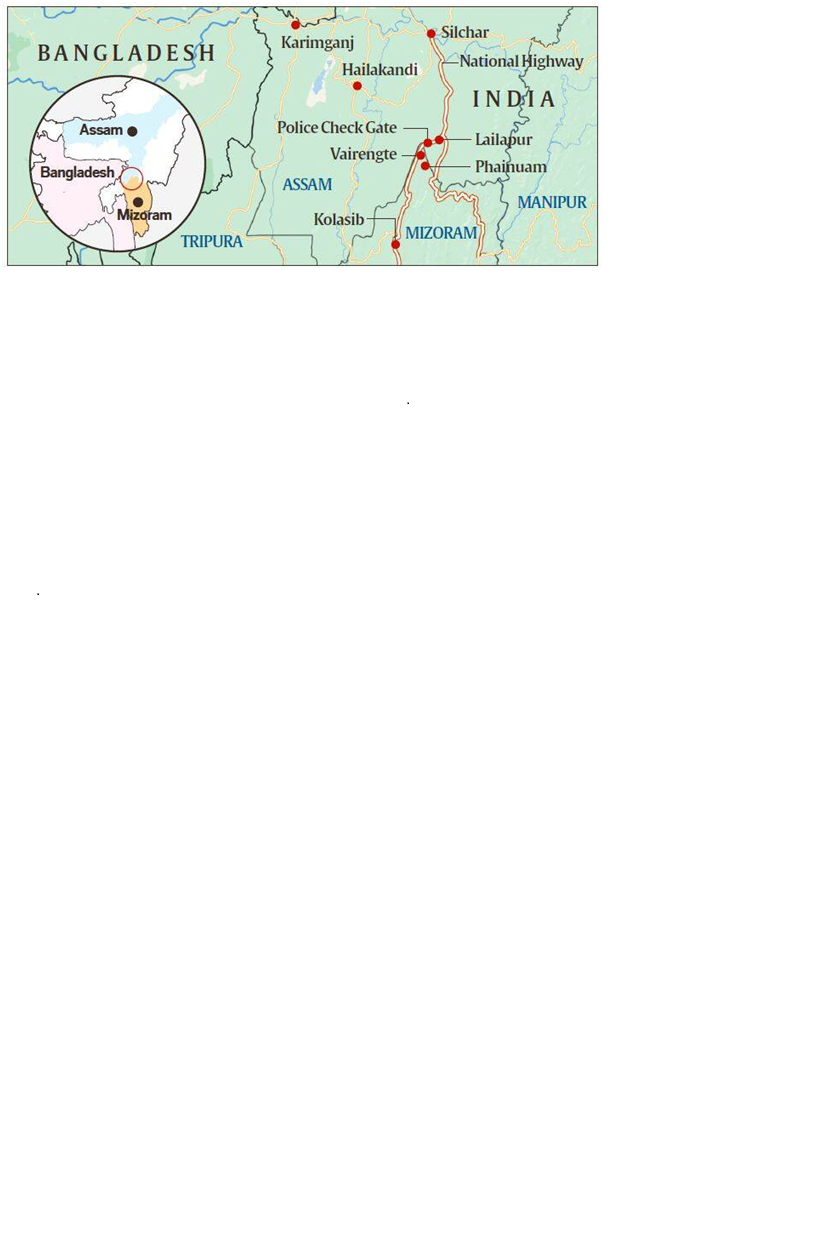
28/07/21 09:25 AM IST


What happened in October 2020?
Residents of Lailapur village in Assam’s Cachar district clashed with residents of localities near Vairengte in Mizoram’s Kolasib district. Days before this clash, on October 9, similar violence had taken place on the border of Karimganj (Assam) and Mamit (Mizoram) districts. On October 9, a farm hut and a betel nut plantation belonging to two Mizoram residents were set on fire.
In the second incident in Cachar, some people from Lailapur had pelted Mizoram police personnel and Mizoram residents with stones. “In turn, Mizoram residents mobilised and went after them,” Kolasib Deputy Commissioner H Lalthangliana had said.
In the Northeast’s complex boundary equations, showdowns between Assam and Mizoram residents are less frequent than they are between, say, Assam and Nagaland residents.
Nevertheless, the boundary between present-day Assam and Mizoram, 165 km long today, dates back to the colonial era, when Mizoram was known as Lushai Hills, a district of Assam.
The dispute stems from a notification of 1875 that differentiated the Lushai Hills from the plains of Cachar, and another of 1933, that demarcates a boundary between the Lushai Hills and Manipur.
A Mizoram Minister had told The Indian Express last year that Mizoram believes the boundary should be demarcated on the basis of the 1875 notification, which is derived from the Bengal Eastern Frontier Regulation (BEFR) Act, 1873.
Mizo leaders have argued in the past against the demarcation notified in 1933 because Mizo society was not consulted. MZP’s Vanlaltana said the Assam government follows the 1933 demarcation, and that was the point of conflict.
Before the incidents of Monday (July 26) and last October, the last time the boundary saw violence was in February 2018.
On that occasion, the MZP had built a wooden rest house in a forest, ostensibly for use by farmers. The Assam Police and forest department officials had demolished it, saying this was in Assam territory. MZP members had then clashed with Assam personnel, who also thrashed a group of Mizoram journalists who had gone to cover the incident.
Why violence and clashes started?
Lalthangliana said: “According to an agreement between governments of Assam and Mizoram some years ago, status quo should be maintained in no man’s land in the border area. However, people from Lailapur broke the status quo and allegedly constructed some temporary huts. People from Mizoram side went and set fire on them.”
On the other hand, Keerthi Jalli, then Deputy Commissioner of Cachar, had told The Indian Express that the contested land belongs to Assam as per the state’s records.
In the October 9 incident, according to Mizoram officials, the land claimed by Assam has been cultivated for a long time by residents of Mizoram. The Karimganj DC, Anbamuthan MP, however, said that although the contested land was historically cultivated by Mizoram residents, on paper it fell within the Singla Forest Reserve that is under Karimganj’s jurisdiction. Anbamuthan had told The Indian Express that the issue was being resolved.
Mizoram borders Assam’s Barak Valley; both border Bangladesh.
Mizoram’s civil society groups blame “illegal Bangladeshis” (alleged migrants from Bangladesh) on the Assam side. “Illegal Bangladeshis are creating all this trouble. They come and destroy our huts, cut our plants and this time pelted stones on our policemen,” said B Vanlaltana, president of the students’ union MZP (Mizo Zirlai Pawl).
When did the dispute become so bitter?
The dispute has been simmering since Mizoram became a Union Territory in 1972 and then a state in the 1980s. The two states signed an agreement that status quo should be maintained at no-man’s land set up in the boundaries. While alleged transgressions have often happened over the decades, skirmishes have happened very frequently in recent months.
While Assam sees its claimed boundary as transgressed, Mizoram cites unilateral moves by Assam inside Mizoram territory. It alleges that in June last year, Assam officials entered Mamit district and visited some farms; that miscreants entered Kolasib district and burnt down two farm huts; and that Assam officials visited the inter-state border between Vairengte (Mizoram) and Lailapur (Assam) and crossed the duty post manned by the CRPF. Mizoram claims that both Assam and Mizoram authorities have undertaken construction work at Buarchep village of Mizoram, and that the Home Ministry is aware of all these issues.
Last October, Assam Police officers allegedly visited Saihapui ‘V’ in Mizoram and threatened to blockade the inter-state highway. Later that month, the inter-state highway as well as the National Highway connecting the two states was blockaded by individuals at Lailapur in Assam. In November, bombs exploded at Upper Phainuam Lower Primary School in Mizoram. A peace meeting was held between the two states.
In recent months, several huts and small shops have been torched, and violent clashes have taken place on issues as petty as claims over betel nut cultivation, with plantations belonging to two residents of Mizoram allegedly set ablaze. There have been clashes between villagers of Lailapur and Vairengte, and between residents of Karimganj (Assam) and Mamiut (Mizoram).
Where Mizoram accept the boundary?
According to Mizo leaders, the only acceptable boundary is the Inner Line of 1875 on the southern frontier of Cachar, notified as per the BEFR Act. (This was subsequently revised in 1878 as it sought to demarcate the Lushai Hills frontier from the plains of Assam.)
“The present so-called boundary was arbitrarily made in 1930 and 1933 without the consent and approval of the competent authorities and the people of the Lushai Hills, now Mizoram, thereby unreasonably excluding some of the Lushai inhabited areas such as Cachar Zion, Tlangnuam, Lala Bazar and Banga Bazar,” political parties of Mizoram, NGOs and a joint action committee on the border issue wrote in a memorandum submitted to Prime Minister Narendra Modi in 2018.
“It is to the Mizos no more than an imaginary line pushed farther and farther south of the Inner Line of 1875, depriving the Mizos of the gentle slopes and flat lands for the convenience of outside settlers (mainly Bangladeshees) brought by the British,” the memorandum reads. In fact, they were referring to a time when the country of Bangladesh had not even been created.
Who demarcated the boundary ?
Mizoram borders Assam’s Barak Valley, and both border Bangladesh. The boundary between the two states, which runs 165 km today, has a history dating back to the time when Mizoram was a district of Assam and known as Lushai Hills. Boundary demarcations in 1875 and 1933, particularly the second one, are at the heart of the dispute.
The 1875 demarcation, notified on August 20 that year, derived from the Bengal Eastern Frontier Regulation (BEFR) Act, 1873. It differentiated Lushai Hills from the plains of Cachar in Assam’s Barak Valley. This was done in consultation with Mizo chiefs, and it became the basis for the Inner Line Reserve Forest demarcation in the Gazette two years later.
The 1933 demarcation marks a boundary between Lushai Hills and Manipur, beginning at the tri-junction of Lushai Hills, Cachar district and Manipur. The Mizos do not accept this demarcation on the ground that their chiefs were not consulted this time.
How violence started and centre intervened?
A team of around 200 Assam Police led by the IGP, Assam Police, and the DC, SP and DFO of Cachar travelled to the Vairengte autorickshaw stand on Monday. While Assam has reasoned that they went to “resolve matters”, Mizoram has said they “forced their way in”, overrunning security posts.
“The team forcibly crossed a duty-post manned by CRPF personnel stationed there and overran a duty post manned by one section of Mizoram police personnel. The Assam Police also damaged several vehicles that were travelling along the National Highway between Vairengte and Lailapur,” the Mizoram government said in a statement.
The Assam Home Minister, for his part, issued a statement: “In another breach of existing agreements and the existing status quo, Mizoram began constructing a road towards Rengti Basti in Assam, destroying the Inner Line Reserve Forest in Lailapur area. Simultaneously, the Mizoram side also set up a new armed camp on a hillock next to the camp of the neutral force, CRPF, in the same vicinity… a team of Assam officials including an IGP, DIG, DC Cachar, SP Cachar and DFO Cachar went to the area this morning to request the Mizoram side not to disturb the status quo.”
Following the intervention of Union Home Minister Amit Shah — who on Saturday had held closed-door meetings with the Northeast CMs in Shillong and discussed inter-state disputes and other issues — both sides have now retracted their forces.
In its statement, Mizoram has said it wants “that the inter-state border issue with Assam be resolved in an atmosphere of peace and understanding”. It has also called upon Assam to create “congenial environment” for peaceful resolution of the dispute.
Other Border disputes in the region-
Assam, which shares its boundary with all other Northeast states — and from which states such as Nagaland, Meghalaya and Mizoram were carved out — has been involved in disputes with several of its neighbours.
Assam and Nagaland share has a 500-km boundary. Violent conflicts, some leading to deaths, have taken place in several phases since 1965. The Manohar Parrikar Institute for Defence Studies and Analyses published a paper on these clashes in 2008.
With Arunachal Pradesh, Assam shares an around 800-km boundary. Here, the first clashes were reported in 1992. Each state has accused the other of boundary transgressions and illegal encroachment. These issues are now being heard in the Supreme Court.
With Meghalaya, Assam shares a boundary of 884 km. There has been a series of recent flare-ups here, too. The Meghalaya government claims it has 12 areas of disputes with Assam. The Chief Ministers of these states held talks in February this year and agreed on the need to maintain status quo and peace.

17 Sep
'Dehradun and several other districts in Uttarakhand have experienced very heavy rainfall over the past few days, triggering landslides in multiple areas and causing rivers to swel
Read More
08 Sep
'The Rajasthan Coaching Centres (Control and Regulation) Bill, 2025, is a significant piece of legislation passed by the Rajasthan Assembly to regulate and oversee the state's burg
Read More
28 Aug
'Recently, the Indian Space Research Organisation (ISRO) successfully carried out its first Integrated Air Drop Test (IADT-1), a crucial milestone in the preparation for the countr
Read More